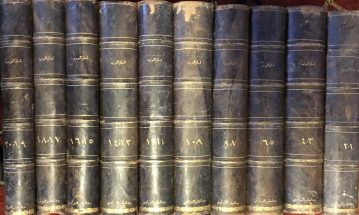Lisan al-Arab, lil-Imam Al-Allama Abi-L-Fadl Jamal Eddine Muhammad ibn Mukarram Ibn Manzur. TWENTY VOLUMES IN TEN. لسان العرب
Ibn Manzur, Jamal al-Din Muhamad ibn Mukarram.
Synopsis
COMPLETE RARE SET. Jamal al-Din Muhamad Bin Mukkaram Ibn Manzur (1233-1311) was born in Tunisia. He is considered to be the author of the most comprehensive dictionary of the Arabic language Lisan al-Arab (The Tongue of the Arabs). According to Brockelmann, Ibn Manzur studied philology and dedicated most of his life to excerpts from works of historical philology. He is said to have left 500 volumes of this work.
Lisan al-Arab was completed by Ibn Manzur in 1290. Comprising 20 printed volumes (in the most frequently cited edition), it is the best known dictionary of the Arabic language, as well as one of the most comprehensive. Ibn Manzur compiled it from other sources to a large degree. The most important sources used were the Tahdhīb al-Lugha of Azharī, the Muhkam of Ibn Sidah, the Nihāya of al-Dhahabi and Jauhari’s Sihāh as well as the glosses of the latter (Kitāb at-Tanbīh wa-l-Īdāh) by Ibn Barrī. It follows the Sihāh in the arrangement of the roots: The headwords are not arranged by the alphabetical order of the radicals as usually done today in the study of Semitic languages, but according to the last radical – which makes finding rhyming endings significantly easier. Furthermore, the Lisan al-Arab notes its direct sources, but not or seldom their sources, making it hard to trace the linguistic history of certain words. Murtadá al-Zabīdī corrected this in his Tāj al-‘Arūs, that itself goes back to the Lisan. The Lisan, according to Ignatius d’Ohsson, was already printed in the 18th century in Istanbul, thus fairly early for the Islamic world.






